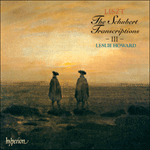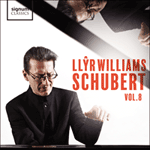
Welcome to Hyperion Records, a British classical label devoted to presenting high-quality recordings of music of all styles and from all periods from the twelfth century to the twenty-first.
Hyperion offers both CDs, and downloads in a number of formats. The site is also available in several languages.
Please use the dropdown buttons to set your preferred options, or use the checkbox to accept the defaults.

Die Gestirne (‘The Firmament’, D444) is a setting of Klopstock’s paraphrase of Psalm 19 (Vulgate 18), ‘The heavens declare the glory of God’, and Liszt’s response to Schubert and Klopstock is full of thunderous orchestral grandeur. Hymne is actually the Geisterchor (‘Chorus of Spirits’)—one of a group of vocal numbers from the ill-fated incidental music to Rosamunde, D797, which Schubert arranged with piano accompaniment (the original is for chorus with brass) which appeared in 1824 as Opus 25, with this particular piece as No 3. (The title of Schubert’s version with piano is confusing, because ‘Hymne’ applies legitimately to quite a number of Schubert songs and choruses.) The text, a likely candidate for the worst piece of German poetry, is by Wilhelmine von Chézy, and deals with Light living in the Depths and Shining (‘In der Tiefe wohnt das Licht. Licht daß leuchtet …’). Both Schubert and Liszt manage to make something quite beautiful from this tripe.
from notes by Leslie Howard © 1995
Die Gestirne, D444 («Le firmament») est une mise en musique de la paraphrase de Klopstock du psaume 19 (Vulgate 18, «Les cieux déclarent la gloire de Dieu»), où la réponse de Liszt à Schubert et Klopstock est remplie d’une grandeur orchestrale retentissante. Hymne, du D797 no4, est en fait le Geisterchor («Chœur des esprits»)—appartenant à un groupe de pièces vocales de la funeste musique de scène pour Rosamunde, que Schubert a arrangée avec un accompagnement pour piano (l’original est pour chœur avec cuivres), apparue en 1824 sous le titre d’opus 25, avec cette pièce particulière en no3. (Le titre de la version de Schubert avec piano est déroutant, car Hymne réfère légitimement à un certain nombre de chants et de chœurs de Schubert). Le texte, candidat probable au pire essai de poésie allemande, est de Wilhelmine von Chézy et traite de Vie légère dans les profondeurs et la lumière («In der Tiefe wohnt das Licht. Licht daß leuchtet»). Schubert aussi bien que Liszt parviennent à produire un certain élément de beauté à partir de ces idioties.
extrait des notes rédigées par Leslie Howard © 1995
Français: Catherine Loridan
Die Gestirne (D444) ist ein Satz von Klopstocks Paraphrase des 19. Psalms (Vulgata 18, „Die Himmel preisen die Glorie Gottes“), und diese Antwort Liszts auf Schubert und Klopstock ist erfüllt von donnernder orchestraler Größe; Hymne ist eigentlich der Geisterchor—eine aus einer Gruppe von Gesangsnummern aus der unglückseligen Bühnenmusik zu Rosamunde, D797, die Schubert für Klavierbegleitung einrichtete (das Original ist für Chor mit Blechbläsern), und die 1824 als Opus 25 erschien, mit diesem besonderen Stück als Nr. 3. (Der Titel von Schuberts Fassung mit Klavier ist verwirrend, da die Bezeichnung Hymne sich berechtigterweise auf eine große Anzahl von Schubert-Liedern und -Chorgesängen anwenden läßt.) Der Text, der als eines der schlechtesten deutschen Gedichte gelten dürfte, stammt von Wilhelmine von Chézy, und handelt vom Licht, das in der Tiefe wohnt und leuchtet. Sowohl Schubert als auch Liszt gelang es, aus diesem Unsinn etwas Schönes zu zaubern.
aus dem Begleittext von Leslie Howard © 1995
Deutsch: Angelika Malbert
 Liszt: Complete Piano Music Liszt: Complete Piano MusicLeslie Howard’s recordings of Liszt’s complete piano music, on 99 CDs, is one of the monumental achievements in the history of recorded music. Remarkable as much for its musicological research and scholarly rigour as for Howard’s Herculean piano p ...» More |
 Liszt: The complete music for solo piano, Vol. 33 - The Schubert Transcriptions III Liszt: The complete music for solo piano, Vol. 33 - The Schubert Transcriptions III‘A fascinating anthology’ (Gramophone) ‘His idiomatic grasp and utter reliability remain as admirable as in earlier instalments. Excellent sonics and informative notes by the performer’ (Am ...» More |
 Schubert: A Schubert Journey Schubert: A Schubert JourneyWelsh pianist Llŷr Williams is widely admired for his profound musical intelligence and the expressive and communicative nature of his interpretations. These recordings were made in conjunction with a critically lauded recital series at the Royal ...» More |
 Schubert: Piano Music, Vol. 8 Schubert: Piano Music, Vol. 8Sixteen of Franz Liszt's sublime Schubert transcriptions, with songs from 'Die schöne Müllerin', 'Winterreise' and elsewhere—the bonbons with which Llŷr Williams bedecked his Cardiff series.» More |
 Liszt: Piano Music Liszt: Piano Music |

